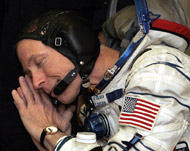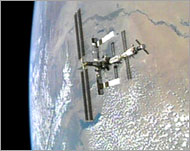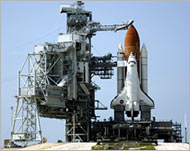Russian rocket, US millionaire blast off
A Soyuz rocket carrying US millionaire scientist Gregory Olsen and a Russian-American crew has lifted off from the Central Asian steppes, launching the world’s third space tourist on a two-day journey to the international space station.

The crew’s family and friends, as well as US and Russian space officials, watched on Saturday from a viewing platform at the Russian-leased Baikonur Cosmodrome in Kazakhstan.
Some in the crowd of more than 100 people, including members of two space-fan tourist groups, gasped at the blastoff and again at the explosive separation of the first of three booster segments, the only audible reaction until the spacecraft entered its initial designated orbit nine minutes after the launch. Then the crowd burst into applause.
As the spacecraft entered orbit, the crew – Olsen, Russian cosmonaut Valery Tokarev and US astronaut William McArthur – reported all was well on board.
Olsen’s daughter Krista Dibsie, 31, accompanied by her husband and 4-year-old son, Justin, videotaped the liftoff.
Justin held his hands over his ears, his mouth wide open.
As she craned her head skyward, tears rolled down Dibsie’s cheeks, and she said quietly: “There goes Dad. Love you, Dad.
“Now I’m nervous for him,” she said. “I wasn’t before but now he’s up there and gosh, he’s out of this world. I can’t believe it.”
Readying for launch
In the hours leading up to the launch, the trio, outfitted in bulky space suits, tested systems in the capsule.
 |
|
Gregory Olsen gestures during |
Shortly beforehand, they lowered the clear plastic covers on their helmets and activated the spacesuits’ oxygen supply.
At Russian Mission Control in Korolyov, outside Moscow, Olsen’s sister Amy McCarroll said her brother was motivated by a devotion to science.
“He is a scientist first of all, and that’s his main reason for going up there … to help mankind, to see what comes from his experiments.”
The spacecraft will rendezvous in two days with the station floating 400km above the Earth. Olsen, Tokarev and McArthur will bring cargo on board and perform experiments.
One planned experiment, designed by Swedish researchers, will measure how inhabitants of the space station are affected by inhaling increased levels of dust in a gravity-free environment. The project is intended to help asthma patients on Earth.
The station’s current inhabitants, Russian Sergei Krikalev and American John Phillips, arrived in April and are to return with Olsen on 11 October, touching down in Kazakhstan.
 |
|
Russia wants to charge the US |
Olsen defended his presence on the Russian-American expedition as a necessary step in the evolution of space flight.
“I would hope that my flight would help if just to make space flight more routine,” he said in a telephone interview on the eve of blast-off.
Olsen, the 60-year-old co-founder of a New Jersey-based infrared-camera company and holder of advanced degrees in physics and materials science, is paying a reported $20 million for participating in the Expedition 12 flight in a deal brokered by Virginia-based Space Adventures.
US-Russia talks
As the Russian-built Soyuz rocket was being fuelled on the launching pad in Kazakhstan’s barren steppes on Friday, top Russian and American officials held tough talks on the future of joint space missions with Nasa’s chief official warning that Moscow’s demands for payment could end US participation.
Nasa administrator Michael Griffin told reporters that a 5-year-old US law that bans space station-related payments to Russia because of Russian participation with Iran in building a nuclear power plant “could end a continuous American presence” on the international space station.
 |
|
US space shuttles were grounded |
The cash-strapped Russian Federal Space Agency has turned to space tourism to generate money. But after transporting US astronauts for free since the 2003 Columbia disaster grounded US shuttle flights, it is threatening to start charging Nasa by the end of the year.
Olsen rejected assertions that space tourism was leading to the commercialisation of space. He is the third non-astronaut to visit the station, preceded by American Dennis Tito four years ago and South African Mark Shuttleworth in 2002.
“One hundred years ago, airline flight was reserved for only a few brave souls. Everyone flies [on planes] nowadays,” he said. “The same will be true of space flight.”
Olsen said he preferred the term “space flight participant” to “space tourist”.
“‘Tourism’ implies that anyone can just write a cheque and go up there. That’s not what happened,” he said.
Unlike pioneering tourist Tito, who was barred from entering the US side of the space station in 2001, Olsen will have free run of the complex, Nasa officials said on Thursday.
He will even be able to use Nasa’s email system and internet phone from orbit.
Asked during a news conference how his health was, Olsen replied: “This has been two years of very hard work. [Soon], I will feel very, very good.”